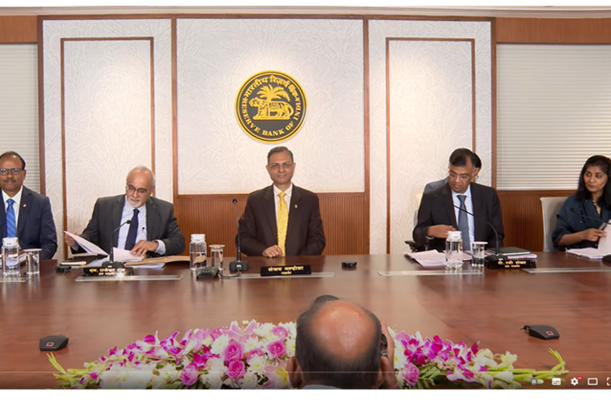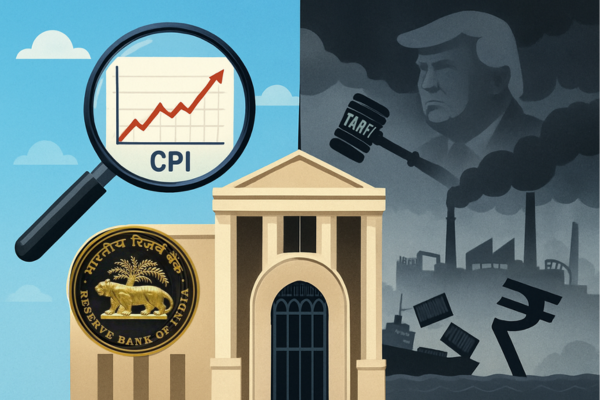.png)
RBI Reopens the Door to Accommodation
By keeping the repo unchanged yet signalling policy space, RBI corrects June’s misstep and restores credibility to its accommodative posture.


Kalyan Ram, a financial journalist, co-founded Cogencis and now leads BasisPoint Insight.
October 1, 2025 at 8:31 AM IST
The Reserve Bank of India has corrected an error of its own making. In June, when the Monetary Policy Committee pivoted prematurely from an accommodative stance to neutral, the central bank shut the signalling channel that markets rely upon. That shift raised the bar for rate cuts so high that monetary policy risked boxing itself in. The October meeting has set that right. By holding the repo at 5.5% but acknowledging space for future easing, Governor Sanjay Malhotra has reopened the door to accommodation.
This is more than a semantic shift. Central banking is as much a dialogue with markets as it is an exercise in balancing models of growth and inflation. When communication forecloses options, it risks weakening the transmission. In reopening that door, the RBI could get bond markets to align with its own view of the economy.
The case for keeping accommodation alive is compelling.
Since the August meeting, growth-inflation dynamics have evolved. The economy remains resilient, supported by a favourable monsoon, buoyant services, and rural demand underpinned by Kharif sowing and reservoir levels. Yet exports are likely to moderate under the weight of US tariffs, while global monetary policy uncertainty clouds the external environment.
The inflation story has moved even further in the RBI’s favour. Headline CPI projection for 2025-26 has been cut sharply from 3.7% in June to 2.6% now, reflecting disinflation in food and the sobering impact of GST rate rationalisation. For the January-March quarter of this financial year and into the next, inflation is aligned with the RBI’s 4% target — the Monetary Policy Report has projected the average inflation in 2026-27 at 4.5%. With limited upside risks and a steady supply outlook, the inflation backdrop provides space to support growth without endangering the price stability mandate.
The MPC also decided to retain the stance at neutral. However, two members—Nagesh Kumar and Ram Singh—were of the view that the stance should be changed back to accommodative. That this preference for accommodation has resurfaced just four months after the June shift to neutral is telling. Semantics aside, the message is clear: accommodation remains in place, and today’s posture is fundamentally different from the June messaging.
Why then not act today?
That remains an old question in central banking. The conventional wisdom says that if policy space is available, it should be used. Yet the MPC’s caution reflects two considerations. First, the full impact of earlier front-loaded rate cuts and liquidity injections is still working its way through the system. Second, the government has already delivered fiscal support through GST and income tax rate cuts. By waiting, the RBI ensures that the effects of both fiscal and monetary measures are visible before the next policy move.
The pause should not be mistaken for hesitation. It is more a matter of calibration. By keeping options alive, the RBI preserves the flexibility to respond to growth shocks while giving itself time to watch how demand evolves.
That balance is central to the October message.
Market Signal
Bond markets are acutely sensitive not only to actual rate moves but also to the communication around them. In June, the shift to neutral sent the wrong signal. Yields hardened as expectations of future cuts were all but erased. This time, the RBI has corrected course by explicitly noting that policy space has opened up. That makes all the difference.
Even so, the market is unlikely to respond with enthusiasm right away. Traders are still smarting from the absence of a rate cut in this policy, and it will take time for expectations to re-anchor. What could shift sentiment decisively is the combination of future easing and the possibility of RBI bond purchases in the January–March quarter, when maturing foreign exchange swaps create a natural liquidity gap. Such operations, alongside rate cuts, would reassure markets that monetary accommodation will not just be signalled but also delivered in tangible form.
The significance lies in the signalling channel as much as in the transmission channel. By reassuring markets that easing remains a live option, the RBI has improved the environment for credit and investment. Lower projection for inflation, anchored by GST rationalisation and food disinflation, further strengthens this transmission. The central bank’s credibility has been restored not through action, but through clarity.
The October statement also underscores the importance of communication as a policy tool in its own right. The Governor stressed that the RBI would remain vigilant, proactive, and consistent in its messaging. That is an acknowledgement that in a volatile global setting, policy signals must work alongside actions to maintain alignment with markets.
The fact that the RBI has not shut the door again is in itself a strong message. Markets no longer see a high bar for rate cuts. Instead, they now view easing as a live option that can be deployed if trade headwinds deepen or global conditions tighten. That correction is the real policy move of October.
The road ahead will not be straightforward. Growth projections have been revised upward for the first half of the year, but the latter half is expected to face drag from tariff-hit exports. Inflation may surprise again, but for now the trajectory is benign. The government’s fiscal stance has added momentum to consumption. Against this backdrop, the central bank’s decision to wait rather than act is sensible.
The lesson from June was that communication errors can be as costly as policy errors. Closing the door prematurely risked undermining transmission and credibility. By contrast, today’s stance ensures that markets and monetary policy are again pulling in the same direction. That is vital for a financial system in which signalling through yields, spreads, and credit conditions carries as much weight as the repo rate itself.
The October policy is less about holding the repo at 5.5% and more about restoring the central bank’s flexibility. By reopening the door to accommodation, the RBI has corrected its June misstep, reassured markets, and aligned its stance with the evolving macroeconomic reality. The bar for easing has been lowered, and the window is now open. What matters is that markets know it is open, and that the central bank has demonstrated its willingness to use it if needed.
Also read:
RBI’s Insulated Optimism Jars with Ground Reality
RBI Breaks Old Orthodoxy with Regulatory Measures
Partly Monetary Policy, Largely Credit Policy
Banks Poised to Challenge NBFCs As RBI Unshackles Restrictions



